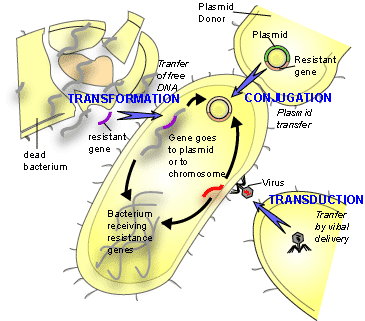1. The microorganism must be found in abundance in all organisms suffering from the disease, but should not be found in healthy organisms.To most people this sounds quite reasonable and represents a sound basis for examining disease.
2. The microorganism must be isolated from a diseased organism and grown in pure culture.
3. The cultured microorganism should cause disease when introduced into a healthy organism.
4. The microorganism must be reisolated from the inoculated, diseased experimental host and identified as being identical to the original specific causative agent.
http://en.wikipedia.org/wiki/Koch%27s_postulates
However, biology is invariably much more nuanced than this, and every one of these postulates is incomplete and somewhat inaccurate.
Koch, himself, recognized that there were significant exceptions to postulates one and three during his own studies, by recognizing that postulate one was violated by asymptomatic carriers of disease [specifically cholera and typhoid fever]. As a result, postulate one is not a universal condition that can be applied when assessing a pathogen.
Similarly postulate number three was modified to indicate "should" rather than "must" since not all organisms that are exposed to an infectious agent will actually acquire the infection. Again, there may be numerous mitigating factors that preclude postulate three from being fulfilled.
As to the others, well, the second postulate may need to be modified for many microorganisms that cannot be cultured.
Consequently, there have been a new set of proposed postulates taking the molecular approach as follows:
1. "The phenotype or property under investigation should be associated with pathogenic members of a genus or pathogenic strains of a species." Additionally, the gene in question should be found in all pathogenic strains of the genus or species but be absent from nonpathogenic strains[citation needed].Unfortunately it largely isn't possible to apply these postulates to a particular gene. Since many animal models simply don't exist for human diseases, we also have the problem that many pathogens can't be genetically manipulated (1).
2. "Specific inactivation of the gene(s) associated with the suspected virulence trait should lead to a measurable loss in pathogenicity or virulence." Virulence of the microorganism with the inactivated gene must be less than that of the unaltered microorganism in an appropriate animal model.
3. "Reversion or allelic replacement of the mutated gene should lead to restoration of pathogenicity." In other words, reintroduction of the gene into the microbe should restore virulence in the animal model.
4. "The gene, which causes virulence, must be expressed during infection."
5. "Immunity must be protective."
http://en.wikipedia.org/wiki/Molecular_Koch%27s_postulates
So where does this leave us.
Certainly Koch's original postulates and even the revised molecular postulates are important guidelines in establishing causation for any particular infectious agent. However, what should also become increasingly clear is that biology is not subject to such neat "laws". Exceptions abound, and for every instance where a particular condition is met, there may well be numerous others that violate the same condition. The number of interactions and variations that occur are simply too robust to be confined to a particular set of rules.
This certainly doesn't mean that we can never know or discover increasingly refined ways of dealing with diseases and infectious agents, but it does suggest that we need to be more prudent and recognize that biological solutions are rarely absolute. We must continuously be aware that we are dealing with complex ecosystems; host and microbiota. These organisms are highly adaptable and responsive to rapid changes in that environment.
 What is even more daunting is that there is a sense that adaptations occur because of random mutations from which natural selection determines the outcome. While generally true, this isn't actually the case where many of these organisms already possess the genes necessary [or acquire them] to cope with radical changes, and consequently are capable of "turning on" the required genes. It isn't as if these organisms necessarily have to wait around for mutations before they can viably respond to these selection pressures (2).
What is even more daunting is that there is a sense that adaptations occur because of random mutations from which natural selection determines the outcome. While generally true, this isn't actually the case where many of these organisms already possess the genes necessary [or acquire them] to cope with radical changes, and consequently are capable of "turning on" the required genes. It isn't as if these organisms necessarily have to wait around for mutations before they can viably respond to these selection pressures (2). As a result, we need to be much more cognizant of the inter-connectedness of all these elements. No simple "slash and burn" strategies will suffice for our long-term coexistence with these organisms. Like it or not, they are as much a part of our lives and survival as the individual cells of our body. Similarly, they may become problematic or they may be a help. Just as our cells may become a problem [i.e. cancers], we cannot simply presume that the elimination of these organisms represents any kind of a solution. Many of these microbes don't actively do anything to protect us except in occupying "real estate" that precludes others from colonizing it (3).
In fact, I expect that a major breakthrough in public perception and understanding of these microbes would occur if we stopped using the word infection [in such a colloquial sense] and viewed it as a colonization effort. In that way, the dynamic of what is transpiring becomes a bit more clear, as well as providing indications of what types of responses might be appropriate when we are faced with an undesirable resident.
------------------------------------------------------------------
(1)
http://virusmusings.blogspot.com/2012/12/the-end-of-kochs-postulates_19.html
http://jmm.sgmjournals.org/content/56/11/1419.full.pdf+html
(2)
http://textbookofbacteriology.net/resantimicrobial_3.html
(3)
http://www.medicalnewstoday.com/articles/251759.php




Comments